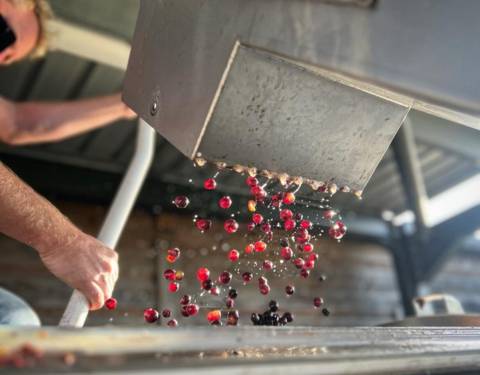
WineGB Releases Report on 2023 Harvest

‘Near Perfect Year’ for wine from 2023 vintage
WineGB is celebrating what they believe will be Great Britain’s largest-ever grape harvest. In the industry’s post-harvest report – ‘2023 Harvest Report – the big one’ – this ‘miracle’ harvest is set to produce an estimated 20-22m bottle production. Other key statistics:
- The harvest is 50% bigger than Britain’s previous record year in 2018.
- The top 25 per cent of vineyards recorded an average of 15.60 tonnes/-ha (6.31 tonnes/-acre).
- The top four grapes Chardonnay, Pinot Noir, Meunier and Bacchus performed exceptionally well, with the average of all vineyards almost reaching 10 tonnes per hectare.
- Yields have risen as more vines have been planted. In the last five years alone, hectarage has grown by nearly 75% and hectarage in production today is over 1,000ha higher than in 2018.
Yield data was gathered from WineGB’s members and represents the most comprehensive early study available. Producers and growers of all sizes, and across the wine growing regions in England and Wales, took part. The report was authored by UK viticulture consultant Stephen Skelton MW.
Weather and plantings meant that there were the best yields ever
Despite a lacklustre cold summer that most of us wanted to escape, the conditions throughout the year proved perfect for wine production boosted by the late heat in September. So, something to cheer about.
The highest yields were achieved in the drier and warmer regions, East Anglia, the South East, and Wessex (Hampshire, Wiltshire, Dorset, Isle of Wight). Investment in the last five years has led to a substantial increase in vine plantings. Vineyard hectarage now in full production is some 3,230ha, compared to 2,138ha in 2018 – a growth of 151%.
Chardonnay, Pinot Noir, Meunier and Bacchus, which account for more than 75% of the UK planted area (Wine Standards March 2023), performed exceptionally well, with the average of all vineyards almost reaching 10 tonnes per hectare, and the top quartile exceeding all estimates with an average across the four varieties reaching 15.9 tonnes/-ha (6.43 tonnes/-acre).
2023 will be remembered as a near perfect year, with very little spring frost (affecting only 6% of respondent vineyards compared to 29% in 2022), text-book flowering weather in June and despite the generally wet and often dull summer (July and August), some exceptionally warm spells in September and October. Picking started with the earlier ripening varieties on 2 September, with the major varieties in the larger regions (and where the crops were heaviest) getting underway at the beginning of October and continuing for the first three weeks of the month.
Vineyards reported heavy crop and bunch weights. Whilst ripeness levels were lower than average, as were acids, winemakers are optimistic about the quality of the fruit and resulting wine.
Stephen Skelton MW said:
“2023 will be a vintage to remember. The excellent yields are attributed to not only the near perfect weather for grapes at key times of the growing season, but also comes on the back of more hectares than ever before coming into production, having seen nearly 75% growth in plantings in the last five years alone.”
Nicola Bates, CEO WineGB said:
“There was a silver lining to our miserable summer, and that is a fantastic season for wine. UK consumers are drinking more and more home produce and at the same time exports are going up especially in the Nordics and Japan. We look forward to having more wine to present to our growing consumer base.
“So to be on trend ensure that you are serving English and Welsh wines for Christmas and New Year. There has never been a better time to buy British.”
• You can read the full report here.
• The data this report is based upon was collected via a voluntary survey to which 132 vineyard owners responded. Between them these producers grow 2,000-ha of vines with 1,700-ha of four year’s old or more and therefore in full production. This represents 50% of the anticipated national cropping area for 2023.
• The final bottle production figures will be released in spring 2024 by Wine Standards, who are responsible for data submissions from all registered wineries in the UK
Explore WineGB


